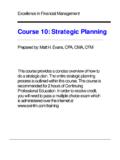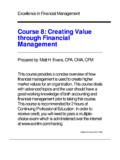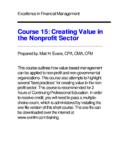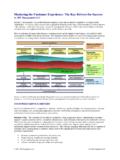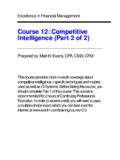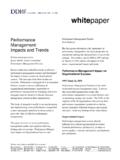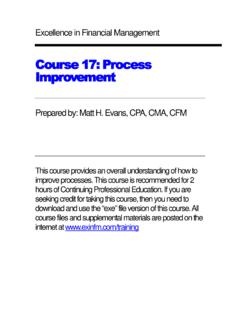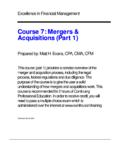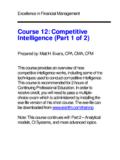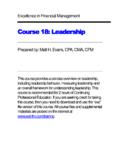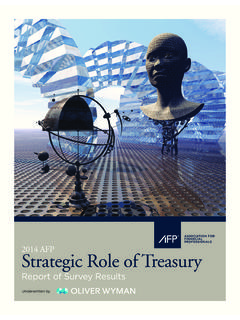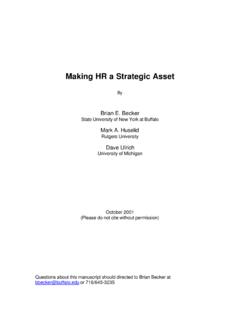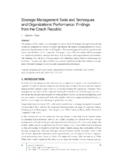Transcription of Course 2: Financial Planning and Forecasting - exinfm
1 Course 2: Financial PlanningCourse 2: Financial PlanningCourse 2: Financial PlanningCourse 2: Financial Planningand Forecastingand Forecastingand Forecastingand ForecastingPrepared by: Matt H. Evans, CPA, CMA, CFMThis Course provides a basic understanding of howto prepare a Financial plan (budgeted financialstatements). This Course will also discuss some ofthe problems associated with budgeting along with"best practices" in budgeting. This Course isrecommended for 2 hours of ContinuingProfessional Education. In order to receive credit,you will need to pass a multiple choice exam whichis administered over the internet March 2000 Excellence in Financial ManagementThe First StepsIntroductionFinancial Planning is a continuous process of directing and allocating Financial resources tomeet strategic goals and objectives.
2 The output from Financial Planning takes the form ofbudgets. The most widely used form of budgets is Pro Forma or Budgeted FinancialStatements. The foundation for Budgeted Financial Statements is Detail Budgets. DetailBudgets include sales forecasts, production forecasts, and other estimates in support of theFinancial Plan. Collectively, all of these budgets are referred to as the Master can also break Financial Planning down into Planning for operations and Planning forfinancing. Operating people focus on sales and production while Financial planners areinterested in how to finance the operations. Therefore, we can have an Operating Plan and aFinancial Plan. However, to keep things simple and to make sure we integrate the processfully, we will consider Financial Planning as one single process that encompasses bothoperations and with strategic PlanningFinancial Planning starts at the top of the organization with strategic Planning .
3 Since strategicdecisions have Financial implications, you must start your budgeting process within thestrategic Planning process. Failure to link and connect budgeting with strategic Planning canresult in budgets that are "dead on arrival." strategic Planning is a formal process for establishing goals and objectives over the long Planning involves developing a mission statement that captures why theorganization exists and plans for how the organization will thrive in the future. Strategicobjectives and corresponding goals are developed based on a very thorough assessment ofthe organization and the external environment. Finally, strategic plans are implemented bydeveloping an Operating or Action Plan. Within this Operating Plan, we will include acomplete set of Financial plans or Plans (Budgets) Operating Plan strategic PlanNOTE: Short Course 10 describes how to prepare a strategic Sales ForecastIn order to develop budgets, we will start with a forecast of what drives much of our financialactivity; namely sales.
4 Therefore, the first forecast we will prepare is the Sales Forecast. Inorder to estimate sales, we will look at past sales histories and various factors that influencesales. For example, marketing research may reveal that future sales are expected tostabilize. Maybe we cannot meet growing sales because of limited production capacities ormaybe there will be a general economic slow down resulting in falling sales. Therefore, weneed to look at several factors in arriving at our sales we have collected and analyzed all of the relevant information, we can estimate salesvolumes for the Planning period. It is very important that we arrive at a good estimate sincethis estimate will be used for several other estimates in our budgets.
5 The Sales Forecast hasto take into account what we expect to sell at what sales 1 SALES FORECASTP roduct Volume Price Total SalesLace Shoes16,000$ $ 720,000 Percent of SalesWe now need to estimate account changes because of estimated sales. One way to estimateand forecast certain account balances is with the Percent of Sales Method. By looking atpast account balances and past changes in sales, we can establish a percentagerelationship. For example, all variable costs and most current assets and current liabilities willvary as sales 1 ESTIMATED ACCOUNTS RECEIVABLEPast history shows that accounts receivable runs around 30% of sales. Wehave estimated that next year's sales will be $ 160,000.
6 Therefore, ourestimated accounts receivable is $ 48,000 ($ 160,000 x .30).3 Detail BudgetsWe also need to prepare several detail budgets for developing a Budgeted IncomeStatement. For example, production must be planned for our estimated sales of 16,000 unitsfrom Exhibit 1. The Production Department will need to budget for materials, labor, andoverhead based on what we expect to sell and what we expect in 2 PRODUCTION BUDGETP lanned Sales (Exhibit 1)16,000 Desired Ending Inventory 1,500 Total Units17,500 Less Beginning Inventory( 3,000)Planned Production14,500 Once we have established our level of production (Exhibit 2), we can prepare a MaterialsBudget. The Materials Budget attempts to forecast the level of purchases required, taking intoaccount materials required for production and inventory levels.
7 We can summarize materialsto be purchased as:Materials Purchased = Materials Required + Ending Inventory - Beginning InventoryEXHIBIT 3 MATERIALS BUDGETLace Shoes require .25 square yards of leather and leather is estimated tocosts $ per yard next year. Materials Required = 14,500 (Exhibit 2) = 3,625 Required for Production3,625 Desired Ending Inventory 375 Total Materials4,000 Less Beginning Inventory( 500)Total Materials Required3,500 Unit Cost for Materials x $ Materials Purchased $ 17,500 The second component of production is labor. We need to forecast our labor needs based onexpected production. The Labor Budget arrives at expected labor cost by applying anexpected labor rate to required labor 4 LABOR BUDGETLace Shoes require.
8 50 hours to produce one ,500 units x .50 = 7,250 expected hourly labor rate next year is $ Production Hours 7,250 Hourly Labor Rate x Labor Costs $ 87,000As production moves up or down, support services and other costs related to production willalso change. These overhead costs represent the third major costs of production. Each itemthat comprises overhead may warrant independent analysis so that we can determine whatdrives the specific cost. For example, production rental equipment may be driven byproduction orders while depreciation is driven by levels of capital investment 5 OVERHEAD BUDGET (Based on Unique Drivers)Estimated for each line item as follows:Indirect Labor Costs *$ 12,000 Utilities 5,000 Depreciation 3,000 Maintenance 1,000 Insurance and Taxes 4,000 Total Overhead Costs$ 25,000*Production Supervision and InspectionOnce production costs (direct materials, direct labor, and overhead) have been budgeted, wecan work these numbers into our beginning inventory levels for Direct Materials, Work InProgress, and Finished Inventory.
9 Beginning inventory levels are actual amounts from thelast reporting period. We need to apply our costs based on what we want ending inventory tobe. The end-result is a Budget for Cost of Goods Sold, which we will use for our ForecastedIncome 6 COST OF GOODS SOLD BUDGETD irectWork InFinishedMaterials Progress InventoryBeginning Inventory$ 2,500$ 16,000$ 46,000 Purchases (Exhibit 3) 17,500 Less Ending Inventory ( 1,875)Materials Required 18,125 Direct Labor (Exhibit 4) 87,000 Overhead (Exhibit 5) 25,000 Total Manufacturing Costs$ 130,125 130,125 Total Work In Progress 146,125 Less Ending Inventory ( 12,000)Cost of Goods Manufactured$ 134,125 134,125 Cost of Goods Available for Sale 180,125 Less Ending Inventory ( 36,000)
10 Cost of Goods Sold$ 144,125We can now finish our estimate of expenses by looking at all remaining operating first major type of operating expense is marketing. Marketing and Sales Manager's willprepare and submit a Marketing Budget to upper level management for 7 MARKETING BUDGETE stimated for each line item per the Marketing Department:Marketing Personnel$ 75,000 Advertising & Promotion 42,000 Marketing Research 12,000 Travel & Personal Expenses 6,500 Total Marketing Expenses $ 135,500 The final area of operating expenses is the administrative costs of running the overallbusiness. These types of expenses will be estimated based on past trends and what weexpect to happen in the future. For example, if the company has plans for a new computersystem, then we should budget for additional technology related expenses.
